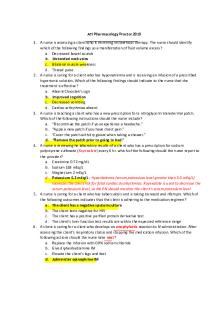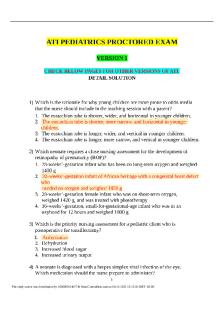Medical surgical ATI proctored exam review 2020 PDF

| Title | Medical surgical ATI proctored exam review 2020 |
|---|---|
| Course | Nursing Leadership |
| Institution | College of the Sequoias |
| Pages | 52 |
| File Size | 1.1 MB |
| File Type | |
| Total Downloads | 51 |
| Total Views | 169 |
Summary
Medical surgical ATI proctored exam notes...
Description
Med Surg ATI Proctored Exam Review What would you do for wound Evisceration (removal of internal organs), Emergency management? Saline cover wound What would you do for an ASTHMA emergency management of a bee sting allergies? Pen Seizures and Epilepsy: Seizure precautions During a seizure: 1) Position client on the floor 2)Provide a patent airway 3) Turn client to side 4) Loosen restrictive clothing
Epi
Cancer treatment options: Protective Isolation If WBC drops below 1,000, place the client in a private room and initiate neutropenic precautions. - Have client remain in his room unless he needs to leave for a diagnostic procedure, in that case transport patient and place a mask on him. - Protect from possible sources of infection (plants, change water in equipment daily) - Have client, staff and visitors perform frequent hand hygiene, restrict ill visitors - Avoid invasive procedures (rectal temps, injections) - Administer (neupogen, neulasta) to stimulate WBC production Infection control: Appropriate room assignment Standard Precautions: 1. applies to all patients 2. Hand washing a. alcohol based preferred unless hands visually soiled ( then soap and water ) 3. Gloves - when touching anything that has the potential to contaminate. 4. Masks, eye protection & face shields when care may cause splashing or spraying of body fluids Droplet: 1. private room or with someone with same illness 2. masks Airborne: 1. private room 2. masks or respiratory protection devices a. use an N95 respirator for tuberculosis 3. Negative pressure airflow 4. full face protection if splashing or spraying is possible Contact: 1. private room or room with same illness 2. gloves & gowns 3. disposal of infections dressing materials into a single, nonporous bag without touching the outside of the bag TB: Priority action for a client in the emergency department respirator
-Wear an N95 or HEPA
-Place client in negative airflow room and implement airborne precautions
-use barrier protection when the risk of hand or clothing contamination exists Immunizations: Recommended vaccinations for older adult clients Adults age 50 or older: - Pneumococcal Vaccine (PPSV) - Influenza vaccine - Herpes Zoster Vaccine - Hepatitis A - Hepatitis B - Meningococcal Vaccine
Pulmonary Embolism: Risk factors for DVT - Long term immobility - Oral contraceptives - Pregnancy - Tobacco use - Hypercoagulabilty - Obesity - Surgery - Heart failure or chronic A-Fib - Autoimmune hemolytic anemia (sickle cell) - Long bone fractures - Advanced age
Disorders of the male reproductive system: Complications of continuous irrigation following Trans-urethral Resection - Urethral trauma - Urinary retention - Bleeding - Infection Non-modifiable risk factors 1) Age 2) Gender 3) Genetics 4) Developmental level
Modifiable risk factors 1) Smoking 2) Exercise 3) Health education and awareness 4) Nutrition 5) Sex practices Emergency nursing - Triage BASED ON ACUITY 1) Emergent- Life threatening situation going on. 2) Urgent - Need to be treated soon but not life threatening. 3) Non urgent- The patient can wait for an extended period of time, without big issues.
Mass Casualty Event Class 1 - RED TAG - Immediate threat to life Examples: 1) Breathing issues 2) Chest pain 3) Heart attack coming on 4) Airway problem Class II - YELLOW TAG - Major injuries that require immediate treatment but not life threatening. Examples: 1) Major fracture
Class III - GREEN TAG - Minor injury that does not require immediate attention. EXAMPLES: 1) Abrasion 2) Laceration
Class IV - BLACK TAG - Expected to die EXAMPLES: 1) Penetrating head wound Triage priority setting 1) Red tag 2) Yellow Tag 3) Green tag 4) Black tag
Priorities: general rule A - Airway - Secure the airway by head tilt , chin lift maneuver unless a fracture in cervical spinal. Brain injury or death in 3 - 5 minutes if airway not patent. B- Breathing - Auscultation of breath sounds, Chest expansion and respiratory effort, Rate and depth of respiration's, Look for chest trauma, Determine tracheal position, Check for jugular vein distension. C- Circulation - Heart rate, BP, Peripheral pulses, Cap refill. D - Disability - Clients level of consciousness with: 1) Glasgow coma scale a)...
Similar Free PDFs

ATI Proctored Medical surgical guide
- 52 Pages

ATI Medical Surgical Notes
- 2 Pages

Pharm-ATI Proctored Exam
- 20 Pages

ATI Proctored Exam Maternal Newborn
- 32 Pages

Maternal ATI Exam 2 Proctored
- 7 Pages
Popular Institutions
- Tinajero National High School - Annex
- Politeknik Caltex Riau
- Yokohama City University
- SGT University
- University of Al-Qadisiyah
- Divine Word College of Vigan
- Techniek College Rotterdam
- Universidade de Santiago
- Universiti Teknologi MARA Cawangan Johor Kampus Pasir Gudang
- Poltekkes Kemenkes Yogyakarta
- Baguio City National High School
- Colegio san marcos
- preparatoria uno
- Centro de Bachillerato Tecnológico Industrial y de Servicios No. 107
- Dalian Maritime University
- Quang Trung Secondary School
- Colegio Tecnológico en Informática
- Corporación Regional de Educación Superior
- Grupo CEDVA
- Dar Al Uloom University
- Centro de Estudios Preuniversitarios de la Universidad Nacional de Ingeniería
- 上智大学
- Aakash International School, Nuna Majara
- San Felipe Neri Catholic School
- Kang Chiao International School - New Taipei City
- Misamis Occidental National High School
- Institución Educativa Escuela Normal Juan Ladrilleros
- Kolehiyo ng Pantukan
- Batanes State College
- Instituto Continental
- Sekolah Menengah Kejuruan Kesehatan Kaltara (Tarakan)
- Colegio de La Inmaculada Concepcion - Cebu










